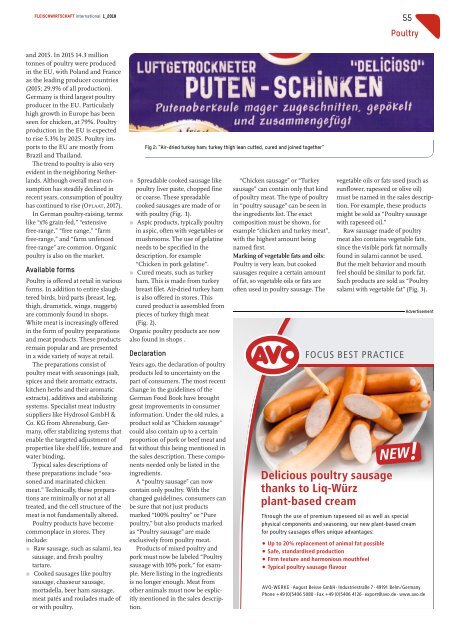FLEISCHWIRTSCHAFT international 1/2018
Create successful ePaper yourself
Turn your PDF publications into a flip-book with our unique Google optimized e-Paper software.
Fleischwirtschaft <strong>international</strong> 1_<strong>2018</strong><br />
55<br />
Poultry<br />
and 2015.In2015 14.3 million<br />
tonnes of poultry were produced<br />
in the EU, with Poland and France<br />
as the leading producer countries<br />
(2015:29.9% of all production).<br />
Germany is third largest poultry<br />
producer in the EU. Particularly<br />
high growth in Europe has been<br />
seen for chicken, at 79%. Poultry<br />
production in the EU is expected<br />
to rise 5.3% by 2025. Poultry imports<br />
to the EU are mostly from<br />
Brazil and Thailand.<br />
The trend to poultry is also very<br />
evident in the neighboring Netherlands.<br />
Although overall meat consumption<br />
has steadily declined in<br />
recent years, consumption of poultry<br />
has continued to rise (OPLAAT,2017).<br />
In German poultry-raising, terms<br />
like “x%grain-fed,” “extensive<br />
free-range,” “free range,” “farm<br />
free-range,” and “farm unfenced<br />
free-range”are common. Organic<br />
poultry is also on the market.<br />
Available forms<br />
Poultry is offered at retail in various<br />
forms. In addition to entire slaughtered<br />
birds, bird parts (breast, leg,<br />
thigh, drumstick, wings, nuggets)<br />
are commonly found in shops.<br />
White meat is increasingly offered<br />
in the form of poultry preparations<br />
and meat products. These products<br />
remain popular and are presented<br />
in awide variety of ways at retail.<br />
The preparations consist of<br />
poultry meat with seasonings (salt,<br />
spices and their aromatic extracts,<br />
kitchen herbs and their aromatic<br />
extracts), additives and stabilizing<br />
systems. Specialist meat industry<br />
suppliers like Hydrosol GmbH &<br />
Co.KGfrom Ahrensburg, Germany,offer<br />
stabilizing systems that<br />
enable the targeted adjustment of<br />
properties like shelf life, texture and<br />
water binding.<br />
Typical sales descriptions of<br />
these preparations include “seasoned<br />
and marinated chicken<br />
meat.” Technically,these preparations<br />
are minimally or not at all<br />
treated, and the cell structure of the<br />
meat is not fundamentally altered.<br />
Poultry products have become<br />
commonplace in stores. They<br />
include:<br />
r Rawsausage, such as salami, tea<br />
sausage, and fresh poultry<br />
tartare.<br />
r Cooked sausages like poultry<br />
sausage, chasseur sausage,<br />
mortadella, beer ham sausage,<br />
meat patés and roulades made of<br />
or with poultry.<br />
Fig 2: “Air-dried turkey ham; turkey thigh lean cutted, cured and joined together”<br />
r Spreadable cooked sausage like<br />
poultry liver paste, chopped fine<br />
or coarse. These spreadable<br />
cooked sausages are made of or<br />
with poultry (Fig. 1).<br />
r Aspic products, typically poultry<br />
in aspic, often with vegetables or<br />
mushrooms. The use of gelatine<br />
needs to be specified in the<br />
description, for example<br />
“Chicken in pork gelatine”.<br />
r Cured meats, such as turkey<br />
ham. This is made from turkey<br />
breast filet. Air-dried turkey ham<br />
is also offered in stores. This<br />
cured product is assembled from<br />
pieces of turkey thigh meat<br />
(Fig. 2).<br />
Organic poultry products are now<br />
also found in shops .<br />
Declaration<br />
Years ago, the declaration of poultry<br />
products led to uncertainty on the<br />
part of consumers. The most recent<br />
change in the guidelines of the<br />
German Food Book have brought<br />
great improvements in consumer<br />
information. Under the old rules, a<br />
product sold as “Chicken sausage”<br />
could also contain up to acertain<br />
proportion of pork or beef meat and<br />
fat without this being mentioned in<br />
the sales description. These components<br />
needed only be listed in the<br />
ingredients.<br />
A“poultry sausage”can now<br />
contain only poultry.With the<br />
changed guidelines, consumers can<br />
be sure that not just products<br />
marked “100% poultry”or“Pure<br />
poultry,” but also products marked<br />
as “Poultry sausage”are made<br />
exclusively from poultry meat.<br />
Products of mixed poultry and<br />
pork must now be labeled “Poultry<br />
sausage with 10%pork,” for example.<br />
Mere listing in the ingredients<br />
is no longer enough. Meat from<br />
other animals must now be explicitly<br />
mentioned in the sales description.<br />
“Chicken sausage”or“Turkey<br />
sausage”can contain only that kind<br />
of poultry meat. The type of poultry<br />
in “poultry sausage”can be seen in<br />
the ingredients list. The exact<br />
composition must be shown, for<br />
example “chicken and turkey meat”,<br />
with the highest amount being<br />
named first.<br />
Marking of vegetable fats and oils:<br />
Poultry is very lean, but cooked<br />
sausages require acertain amount<br />
of fat, so vegetable oils or fats are<br />
often used in poultry sausage. The<br />
vegetable oils or fats used (such as<br />
sunflower,rapeseed or olive oil)<br />
must be named in the sales description.<br />
Forexample, these products<br />
might be sold as “Poultry sausage<br />
with rapeseed oil.”<br />
Rawsausage made of poultry<br />
meat also contains vegetable fats,<br />
since the visible pork fat normally<br />
found in salami cannot be used.<br />
Butthe melt behavior and mouth<br />
feel should be similar to pork fat.<br />
Such products are sold as “Poultry<br />
salami with vegetable fat”(Fig. 3).<br />
Advertisement

















